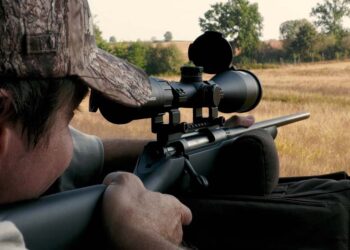
The optical instruments made by Leica start from the legendary cameras to reach the binoculars or the long ones with the particularity of the first binotelemeter, big and heavy as a brick: the definition comes from Maestro Carlo who has owned one for a long time and hardly leaves it at home. given the intrinsic reliability of the product. A lot has come a long way and the arrival of riflescopes and brand new binoculars with the correct measurements based on the parameters now known by all has placed the company at the top of the sector. Said of the observation optics, today we are taking into consideration a target of great stature: the Magnus 2,4-16x56i contains the prerogatives to satisfy an almost total range of hunting needs.
It is good to start from a consideration: in recent years there has been a rush to the percentage of light transmitted by their lenses among the highest caliber manufacturers and 1 or 2 points more were seen and proposed as an entity of absolute value, neglecting to underline how these deviations are undetectable by the human eye, even in its best conditions, including the age of the subject. Today we prefer, and rightly so, to focus more on the values that make the use of the vehicle easier and less tiring.

The perceptible optical values
If by throwing the eye into a telescope, well positioned with respect to the build of the shooter, the eyepiece will be totally clear, without peripheral vignetting, and the image will be clear you will already be at a good point. The width of the exit pupil is a fundamental measure to facilitate the acquisition of the targeted subject and Leica presents the most valuable on the market: the wider it is, the less the search for the exact distance between the eye and the lens, a factor that when hunting, with the postures imposed by the situation, it is often essential for a correct shot and performed with due diligence. The diameter of the lenses, here in particular of the objective, favors the transmission of light with a clear and immediate perception of the subject and of what is around him: it is also necessary to understand, if there is a movement in progress, where our prey will go to position itself (or so it is hoped ...) by placing the reticle in the right area in advance.

The brightness provided by the measurements takes into account the factor 7: the human eye, we repeat in its optimal conditions, can take advantage of the diameter of the front lens equal to the product of the aforementioned factor 7 multiplied by the magnification value. Therefore, the maximum brightness and dimensional encumbrance are the 56 mm obtained precisely from the 7 × 8 multiplication. Then there is another very useful factor, almost decisive, to appreciate the instrument and obtain an optimal service: the chemical coating of the lenses. The progress of the last decade in this sector has proved phenomenal: the result has been achieved thanks to computer simulations where, in a very short time, solutions have been probed in numbers that only in this way it has been possible to achieve. These layered coatings on the optical glasses eliminate the internal reflections guaranteeing the transmission of light already mentioned and at the same time the absence of chromatic aberration, the halo at the edges of the subject: the bare branches of a tree seem to have been created specifically for this verification. .

A value that always proves fatal while hunting is the contrast, in practice the detachment of the subject from the background, often more important than the overall brightness: it happens to ephemeris, those minutes that precede or follow the rising or setting of the sun, or on those winter afternoons when a scarce milky light confuses everything. On such occasions, a handful of extra minutes together with the definition of the game can make the difference between shooting or going home with the pives in the bag.

Mechanics
Optical glasses are the basic component for a telescope to which the mechanical part is attached: the reticle is engraved on the lens, therefore no problem even with strong recoil gauges, and shows the central light point with the day / night variations. The adjustment mechanisms are made of steel and, without going into technical aspects, we can say that each shot corresponds to a precise displacement of the hit point, so the ballistic turret also offers the certainty of putting the shot where you want, returning to the point. zero with absolute regularity. This prerogative represents an essential value.


Considering the maximum magnification at 16x, there is also the adjustment of the parallax on the left turret. In conclusion, this model of the Magnus line is a top-of-the-range product and the values at stake indicate it as the optimal solution for long-range shooting, both hunting and shooting ranges and in all light conditions; the excursion of the magnifications up to the minimum limit of 2,4x does not limit the use of this optic for shooting at close-range and moving targets, other than weight and size.





































